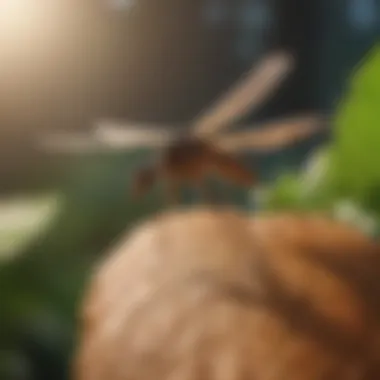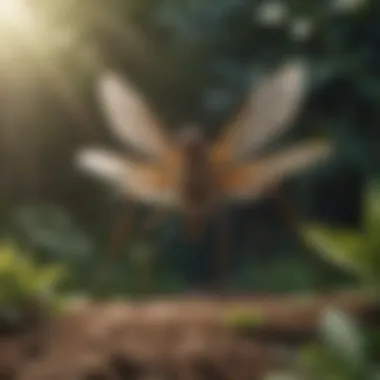Effective Strategies for Crane Fly Pest Control


Intro
Crane flies can be an unwelcome presence in gardens and landscapes. Understanding these insects is crucial for effective pest control. This article aims to provide a detailed overview of crane fly pest control strategies. We will explore their identification, prevention, and management. Learning the biology of crane flies can help mitigate their effects on your garden.
Pest Identification
Common Household Pests
Crane flies often get confused with mosquitoes due to their similar appearance. However, they differ significantly in behavior and impact. Crane flies have long legs and a slender body, giving them a delicate look. There are various species of crane flies, with many found in North America. Identifying these pests correctly is the first step in managing them effectively.
Signs of Infestation
Identifying a crane fly infestation means looking for specific signs:
- Adults may be noticed flying indoors, especially in moist areas.
- The larvae, often referred to as leatherjackets, can be found in soil and grass, feeding on roots and organic material.
- Signs of damage include yellowing or browning patches in the lawn, indicating root damage.
Proper identification helps in choosing the right management strategy.
Prevention Methods
Environmental Modifications
Preventing crane flies begins with modifying the environment. Here are some suggestions:
- Eliminate standing water around the property. Crane flies prefer moist conditions.
- Maintain healthy grass by regularly mowing and aerating. This reduces breeding sites for larvae.
- Use organic materials instead of synthetic fertilizers that may attract them.
Home Maintenance Tips
Home maintenance can play a significant role in prevention:
- Seal cracks and openings to prevent adult flies from entering.
- Clean debris regularly around gutters and patios to reduce moisture.
- Ensure proper drainage in the garden to minimize attraction.
DIY Pest Control Solutions
Natural Remedies
Employing natural remedies can be effective in managing crane fly populations:
- Neem oil is a natural insect repellent that can be sprayed on affected areas.
- Diatomaceous earth can be spread in the garden to deter larvae without harming beneficial insects.
- Garlic sprays may also help in keeping adult flies away.
DIY Traps and Barriers
Creating barriers and traps can further assist in controlling crane flies:
- Sticky traps can be placed near windows to catch flying adults.
- Planting flowers that repel crane flies can provide protection for other plants.
- Homemade barriers made from row covers can protect young plants from infestations.
Each of these methods can be tailored to individual needs, ensuring that homeowners can manage crane fly issues effectively.
Understanding Crane Flies
Crane flies are often misunderstood insects. Most people might think of them merely as nuisances. However, understanding these creatures is crucial for effective pest control. Knowing their biology and behavior can significantly guide management strategies. This knowledge helps in identifying infestations and recognizing their potential impact on gardens and landscapes.
Taxonomy and Classification
Crane flies belong to the family Tipulidae. The classification of these insects can be intricate. They are part of the order Diptera, which means they have a single pair of wings. Within Tipulidae, there are numerous species. Each species may have unique characteristics, which can make identification challenging. Proper understanding of this classification is essential. It allows for targeted control efforts and improved pest management.
Biological Characteristics
Physical Features
Crane flies are often mistaken for large mosquitoes. They exhibit long, slender bodies and long legs, which can be a significant identifying factor. One key characteristic is their size; adult crane flies can range from one to two inches in length. Another essential feature is their elongated neck, which separates their heads from their bodies. This unique attribute allows for greater mobility. The benefits of recognizing these features aids in distinguishing them from harmful insects.
Life Cycle
Crane flies have a complex life cycle that includes four stages: egg, larva, pupa, and adult. Each stage takes a specific time and environmental conditions can speed up or slow down development. Understanding this life cycle helps in determining the best timing for control measures. For instance, the larval stage is when they cause most damage. Knowing when to target treatments can improve effectiveness and reduce the pest population.
Feeding Behavior
Crane flies are primarily herbivores, feeding on grass and plant roots as larvae. This feeding behavior can lead to significant damage in lawns and gardens. Adult crane flies, on the other hand, do not feed. Their reproductive strategies and range of habitats make them adaptable. Recognizing these feeding patterns is crucial for their management. Focusing on the larval stage during pest control provides a more effective approach to combating infestations.
Geographical Distribution
Common Species in North America
In North America, several crane fly species are prominent. Species such as the Tipula paludosa and Tipula oleracea are common. These species thrive in various environments, adapting to different climates and habitats. Understanding which species are prevalent in a specific area is beneficial. It allows for better-targeted control and management strategies that fit local conditions.


Habitats Where Crane Flies Thrive
Crane flies prefer moist environments. They are commonly found in marshes, fields, and gardens with adequate watering. They thrive in well-drained soil, which supports their life cycle. These habitats are often rich in organic matter, making them ideal for egg-laying and larvae development. Identifying these habitats can help homeowners implement preventive measures. Proper landscape management can significantly reduce crane fly populations.
Identifying Crane Fly Infestations
Identifying crane fly infestations is crucial to effective pest management. Early recognition of these insects can prevent further damage to your lawn and garden. Understanding the signs of infestation and distinguishing crane flies from similar species is essential. This knowledge helps homeowners take timely action, reducing potential harm to plants and landscapes.
Signs of Infestation
Detecting the presence of crane fly larvae and the damage they cause are the primary signs of infestation. Knowing these indicators will enable you to assess the severity of the situation and plan appropriate treatment options.
Presence of Larvae
The presence of larvae is a significant indicator of crane fly infestation. These larvae, commonly known as "leatherjackets," contribute to the overall understanding of crane flies because of their destructive feeding habits. The key characteristic of these larvae is their size, which can range from 1 to 2 inches in length, sporting a dark brown color with a smooth, robust body.
Identification of larvae is beneficial in targeting control measures precisely. The unique feature here is their feeding behavior. They primarily feed on the roots of grass, leading to weakening plants, which makes the identification of larvae critical for any gardener or homeowner. Immediate action is advised upon discovery to mitigate further lawn damage.
Damage to Grass and Plants
Damage to grass and plants represents another symptom of crane fly activity. This damage manifests as irregular patches of brown or dead grass, making it an obvious sign of pest issues. The key characteristic of this damage is the pattern it forms, which can resemble drought stress or fungal disease.
Recognizing such symptoms is essential in distinguishing between crane fly damage and other lawn issues, thus helping in formulating an appropriate response. The unique aspect of this damage is its potential to escalate quickly if not managed. If you observe these signs, it is crucial to take action before the damage becomes extensive.
Distinguishing from Similar Species
Misidentification of crane flies can lead to ineffective management strategies. It is important to differentiate them from mosquitoes and other lookalike insects, as doing so can significantly affect pest control measures and results.
Comparison with Mosquitoes
In comparing crane flies with mosquitoes, a few key differences stand out. While both insects share a similar thin body shape and long legs, crane flies are generally much larger. A crucial feature in this comparison is that crane flies do not bite or feed on blood, unlike mosquitoes, which makes them less of a nuisance for homeowners.
This distinction is beneficial, as it clarifies the type of management needed. Crane flies, when misidentified as mosquitoes, may prompt unnecessary control measures like insecticide applications, which are not only ineffective but could harm beneficial insects. Overall, recognizing such differences aids in effective pest management.
Other Lookalike Insects
Other lookalike insects can confuse homeowners trying to identify crane flies. For example, certain species of midges also resemble crane flies. The key characteristic of these insects is their body structure and size, often being smaller and less elongated than crane flies.
Understanding the unique features of these lookalike insects helps in ensuring accurate pest identification. This knowledge is important, as it guides the homeowner to the right course of action for pest management. Failing to accurately identify crane flies can lead to ineffective or misguided pest control efforts, potentially allowing infestations to worsen.
Impact of Crane Flies on the Environment
Understanding the impact of crane flies on the environment is essential for garden enthusiasts and homeowners alike. These insects play a crucial ecological role. They can both positively and negatively affect local ecosystems. This section delves into their ecological contributions and the potential damage they can inflict on lawns and gardens.
Ecological Role
Nutritional Contribution to Ecosystems
Crane flies serve as a food source for numerous predators, including birds and other mammals. They are an important nutrition source, especially during their larval stage. The larvae feed on decaying organic matter, helping to decompose material and recycle nutrients back into the soil.
This decomposition is a beneficial process, as it enhances soil health and promotes plant growth. Thus, the nutritional contribution of crane flies is highly valuable in maintaining ecological balance. However, their presence in large numbers can lead to increased competition for resources.
Role in the Food Chain
Crane flies occupy a specific niche in the food chain. As prey, they are integral to the survival of many bird species and other predators. Their larvae are almost exclusively herbivorous, which means they indirectly benefit flowering plants by supporting pollinators.
This key role ensures their place within an interconnected web of life. However, too many crane flies can lead to overgrazing on grass and other plants, which in turn disrupts the balance of the surrounding ecosystem. Thus, while they are beneficial, they pose potential risks when not managed well.
Potential Damage to Lawns and Gardens
Crane flies, particularly in their larval stage, can cause significant damage to lawns and gardens. They often feed on grass roots, leading to brown patches and thinning turf. Homeowners might initially overlook these signs, mistaking them for drought stress or other diseases. Left untreated, the damage can extend, necessitating costly repairs or replanting.
Moreover, any larvae left untreated can develop into mature crane flies, perpetuating the cycle of infestation. Awareness of their potential impact is key in pest management.
Prevention Strategies
Prevention strategies are critical in managing crane fly infestations. By employing effective methods, homeowners can minimize the potential damage that these pests may cause. Crane flies, while not directly harmful, can lead to significant ecological disturbances, particularly in gardens and lawns. Implementing preventive measures significantly reduces the likelihood of a full-blown infestation, which can save time and resources in the long run.
Cultural Practices
Soil Management
Soil management is a key aspect of prevention against crane flies. Healthy soil contributes to robust plant growth, which in turn makes gardens and lawns less susceptible to pest infestation. Maintaining soil health involves testing pH levels and understanding nutrient composition. This knowledge allows homeowners to amend the soil properly.
A notable characteristic of proper soil management is the incorporation of organic matter, which enhances soil structure and fertility. Organic matter can include compost or well-rotted manure. This is seen as beneficial in the context of pest prevention because it supports beneficial soil organisms that can hinder pest development.
However, soil management requires effort and regular attention. The downside is that it may take time to see noticeable improvements in pest control. Still, the long-term benefits of soil management generally outweigh these challenges.


Watering Techniques
Watering techniques also play an important role in preventing crane fly infestations. Proper watering minimizes standing water, which is conducive to the breeding of many pests, including crane flies. Homeowners should be mindful of their watering schedule, opting for early morning or late afternoon to reduce evaporation and avoid excess moisture on foliage.
The primary feature of effective watering techniques is the emphasis on appropriate volume and frequency. Overwatering can lead to waterlogged soil, which attracts crane fly larvae. Conversely, under-watering stresses plants, making them more appealing to pests. Therefore, balance is crucial in maintaining plant health and reducing infestation risks.
The advantage of proper watering techniques is their simplicity. They can be easily integrated into daily gardening routines. Nonetheless, one challenge is the possibility of neglecting watering schedules, particularly during busy times. Regular monitoring is essential for success.
Barriers and Physical Controls
Netting and Screens
Using netting and screens is a proactive approach to preventing crane fly access to gardens. These physical barriers can limit the entry of adult crane flies, thereby reducing the chances of larvae development in the soil. Netting is particularly effective when used over seedlings and young plants, which are more vulnerable.
The key characteristic of netting is its universality. It can be applied in various settings, from greenhouses to patio gardens. This makes it a popular choice among homeowners looking for straightforward solutions. However, the unique feature of netting is that it must be installed correctly to ensure effectiveness.
One disadvantage is that while netting protects against crane flies, it might also hinder beneficial insects. Homeowners must carefully consider their choices to avoid unintended ecological consequences.
Frequent Lawn Maintenance
Frequent lawn maintenance contributes significantly to pest control efforts. Regular mowing, trimming, and aerating are practices that disrupt crane fly habitats. Keeping grass short reduces places for adults to hide and for larvae to thrive.
A fundamental aspect of maintaining the lawn is its aesthetic appeal. A well-kept lawn not only looks pleasing but also creates an environment that is less inviting to pests. This is why routine maintenance is a beneficial choice in preventing infestations.
The unique feature of consistent lawn care is its adaptability. It can be tailored to fit individual preferences or available time. However, homeowners might find it time-consuming, especially during busy periods. Despite this, the dedication to lawn maintenance pays off with reduced pest populations and an overall healthier landscape.
Control Methods
Control methods are crucial in managing crane fly populations effectively. These methods include a variety of strategies that can be applied based on the severity of the infestation and the specific environment. Utilizing the right combination of approaches helps minimize damage to lawns and gardens while maintaining ecological balance. This section will explore organic control techniques and chemical treatment options, discussing their unique characteristics, advantages, and drawbacks.
Organic Control Techniques
Natural Predators
Natural predators play a vital role in combating crane fly larvae. These predators include birds, smaller mammals, and certain insects that feed on crane fly larvae during their development. By encouraging these natural enemies, homeowners can create an environment that inherently reduces crane fly populations. This method is beneficial because it involves no chemical applications, thus protecting the broader ecosystem. However, it may take time for the predators to establish and reduce larval numbers effectively. Some of the advantages are that it is environmentally friendly but the downside includes the unpredictability of populations and their adaptability in various environments.
Homemade Remedies
Homemade remedies often attract interest due to their ease of use and accessibility. Common ingredients like garlic or neem oil, when diluted and applied to affected areas, can deter crane flies. Their appeal lies in being safe for humans and pets compared to commercial products. However, it is essential to note that these solutions might not provide immediate results. The unique feature is the personalization according to homeowner preferences, making it a popular choice. The advantages include lower costs and reduced chemical exposure, while disadvantages involve inconsistent efficacy and sometimes the need for frequent applications.
Chemical Treatment Options
Insecticides: Pros and Cons
Insecticides are widely used for controlling crane fly populations quickly. They work by disrupting the larval development or killing adults outright. The main advantage of insecticides is their speed of action and thoroughness. Popular insecticides can effectively eliminate infestations in a short time frame. On the con side, the use of insecticides raises concerns about potential harm to beneficial insects and the environment. Understanding when and how to use these products responsibly becomes essential for homeowners.
Application Techniques
Application techniques of insecticides significantly impact their efficiency. Techniques vary from spraying to granulating. Proper application ensures that the product reaches the target area without harming non-target organisms. For instance, applying insecticides during the early morning or late evening reduces the risk to pollinators that are more active during the day. The characteristic of these techniques is precision in distribution, which is vital for effective control. While effective, the downsides involve safety regulations and the proper timing for applications, which can complicate the process for the average homeowner.
Integrated Pest Management (IPM)
Integrated Pest Management (IPM) is a crucial component in the strategy of managing crane fly populations effectively. Rather than relying solely on chemical pesticides, IPM emphasizes a combinational approach that selectively integrates various control methods. The primary aim is to minimize the impact of pests, while also reducing harm to the environment and human health.
The real importance of IPM lies in its sustainability and flexibility. By using a range of techniques, IPM can adapt to specific environmental conditions and fluctuating pest populations. Furthermore, this method is cost-effective over the long term, balancing effective pest management with ecological health and safety considerations.
Principles of IPM
Monitoring and Identification
Monitoring and identification are fundamental to the success of IPM. By regularly assessing pest populations and identifying species, homeowners can refine their control strategies. This process involves observing any signs of crane fly infestation, such as larvae presence in soil or visible damage to plants. Monitoring allows for early detection, which is critical in preventing extensive damage to lawns and gardens.
This aspect is beneficial because it fosters informed decisions. Homeowners can decide when and how to intervene, reducing unnecessary treatments. The unique feature of this monitoring practice is its reliance on tangible evidence rather than assumptions, making it a practical approach.
However, it is essential to remain aware of potential disadvantages. For example, accurate identification can sometimes be complex, especially when dealing with lookalike species. Misidentification may lead to inappropriate control measures, potentially worsening the situation.
Threshold Levels
Threshold levels refer to the specific pest population densities that trigger control measures. Understanding these levels is vital in IPM, as it helps to determine when intervention is necessary. This approach allows homeowners to establish a balance between pest management and the economic, aesthetic, and ecological impacts of control measures.
One key characteristic of threshold levels is their role in preventing overreacting to minor pest populations. By focusing on significant infestations only, users can save resources and avoid damage to beneficial insects in the ecosystem. This focus on thresholds promotes a strategic, rather than reactive, management style, a reason it is regarded as a crucial choice for this article.
The unique aspect of threshold levels is the practicality they bring to pest management. It enables homeowners to assess pest population data and use it in decision-making processes. However, setting these levels requires careful consideration and expertise; improper thresholds could lead to delayed responses to significant infestations.
Combining Techniques for Effective Control


Incorporating Cultural, Biological, and Chemical Controls
Incorporating cultural, biological, and chemical controls is a hallmark of IPM strategy. This combination of techniques enhances the effectiveness of crane fly management while mitigating the adverse effects associated with any one approach.
Cultural controls may include practices like lawn aeration and proper watering techniques to promote healthy grass. Biological controls can involve introducing natural predators of crane fly larvae. Chemical controls, when necessary, are chosen carefully to minimize environmental impact. This holistic approach stands out as a strong choice for the article due to its comprehensive scope.
The unique aspect of this integration is its ability to provide a multi-faceted response to pest issues. By engaging in various control methods, homeowners can address the problem on multiple fronts simultaneously. The benefits are clear — while one strategy might not eliminate a problem entirely, together they often can.
Yet, challenges exist in combining these methods. The process may require more planning and knowledge, and some individuals might be overwhelmed by the variety of options. Moreover, careful monitoring is needed to avoid harmful interactions between different control strategies.
Case Studies of Successful Crane Fly Management
Analyzing case studies related to crane fly management is crucial for understanding the efficacy of various pest control strategies. These studies provide real-world examples that illustrate both the successes and challenges faced by homeowners and professionals alike. Through these case studies, one can learn about effective practices, avoid common pitfalls, and adapt strategies to specific environmental factors. This approach can cultivate a collective knowledge base that benefits all stakeholders involved in managing crane fly populations.
Residential Approaches
Community Best Practices
Community best practices in crane fly management emphasize collaboration among neighbors to address infestations. This shared approach can foster a sense of responsibility and accountability, resulting in a unified strategy against these pests. The key characteristic of community best practices is their emphasis on collective action. By pooling resources and knowledge, communities can achieve more significant results than individual efforts.
One unique feature of this strategy lies in the ability to implement widespread cultural practices, such as maintaining a healthy lawn or coordinating treatment schedules with local pest control services. The advantages of this approach include enhanced effectiveness in controlling crane fly populations and reduced costs through shared resources. However, the effectiveness highly depends on community participation and commitment, which can vary significantly.
Individual Homeowner Experiences
The experiences of individual homeowners provide valuable insights into effective crane fly management tailored to specific circumstances. Homeowners often share their personal methods and successes, contributing to a growing body of knowledge about what works best in various settings. A significant characteristic of these experiences is the diversity of strategies employed, ranging from organic approaches to chemical treatments.
Homeowners frequently highlight organic solutions, such as introducing beneficial insects or implementing specific watering techniques, as effective for controlling crane flies without harming the ecosystem. Unique advantages of these individual experiences include personal anecdotes that resonate well with other homeowners, making this information relatable. However, the disadvantages include the variability in outcomes due to differing environmental conditions and practices that may not apply universally.
Commercial Landscape Solutions
Professional Pest Control Services
Utilizing professional pest control services can be a beneficial choice for those managing crane fly infestations in commercial landscapes. These services often employ trained experts who understand the biology and behavior of crane flies, thus enabling targeted strategies for effective management. A key characteristic of professional services is their access to advanced technology and potent treatment options that may not be available to the public.
The unique feature of professional pest control lies in comprehensive solutions that include assessments, customized treatment plans, and post-treatment monitoring. This can lead to higher success rates in managing crane fly populations over traditional DIY methods. On the downside, the associated costs may deter some property owners, and reliance on external services can reduce the knowledge gained through personal experience.
Long-term Management Strategies
Implementing long-term management strategies is crucial for the sustainable control of crane flies. These strategies focus on ongoing monitoring, timely interventions, and adjusting practices based on population changes. The key characteristic of these strategies is their proactive nature; they aim to prevent infestations rather than merely respond to them.
A notable feature of long-term management is the integration of various approaches, such as soil health improvements, consistent lawn maintenance, and seasonal treatments. The advantages of this approach include reduced incidence of infestations over time and a healthier lawn environment. However, maintaining long-term strategies requires continuous effort and attention, which may be challenging for some property owners.
"Effective management of crane flies depends heavily on community engagement and continuous education on best practices."
By exploring these case studies, readers can gain a clearer understanding of the landscape of crane fly management, facilitating the adoption of more informed strategies.
Future Directions in Crane Fly Research
Research on crane flies is essential for enhancing pest control strategies. As new challenges in pest management emerge, understanding crane fly biology and behavior becomes even more crucial. Future research can lead to better management practices, benefiting both homeowners and professionals in pest control.
This section discusses emerging trends in pest control and identifies research gaps that could offer valuable opportunities for improving crane fly management.
Emerging Trends in Pest Control
Advancements in Biological Control
Biological control is becoming increasingly important in pest management, including crane flies. This method utilizes natural predators or parasites to manage populations effectively. A key characteristic of biological control is its emphasis on long-term solutions rather than quick fixes. This approach often results in a sustainable reduction in crane fly numbers without harming the environment.
One unique feature of biological control is its ability to adapt to various ecological conditions. This adaptability means that it can be applied effectively across different environments. The advantages of biological control include reduced reliance on chemical pesticides and minimal impact on non-target species. However, the disadvantages may include the time required to establish effective predator populations.
Technological Innovations
Technological innovations play a significant role in modern pest management. Intelligent systems and advanced monitoring techniques can help in identifying and managing crane fly populations more accurately. A crucial aspect of these technologies is the deployment of real-time data collection tools, such as drones and automated traps. This allows for precise monitoring and rapid responses to infestations.
The unique feature of technology in pest control relates to its data-driven nature. This enables targeted strategies that can be more efficient and effective than traditional methods. The advantages of these technologies include higher accuracy and efficiency in pest control, while the limitations may involve the initial investment costs and training requirements for effective use.
Research Gaps and Opportunities
Understanding Resistance Mechanisms
Understanding resistance mechanisms in crane flies is critical for developing effective pest management strategies. This research involves exploring how crane flies adapt to various control methods, including chemical treatments. A significant characteristic of this research is its potential to inform the development of more effective pesticides that can overcome resistance.
The unique aspect of studying resistance mechanisms is their dynamic nature. As pest populations evolve, continuous research is necessary to keep pest control strategies effective. One advantage of this research is the chance to create tailored strategies that address specific resistance issues. However, the challenge lies in the complexity of biological systems and the resources required for such studies.
Impact of Climate Change on Crane Fly Populations
Climate change is reshaping ecosystems, affecting crane fly populations. Understanding how these insects respond to changing climates is vital for adaptation strategies in pest control. A key characteristic of this line of research is its interdisciplinary nature, combining entomology, ecology, and climate science.
The unique feature of researching the impact of climate change on crane flies is the potential for proactive management strategies. By predicting how crane fly behavior and populations will shift with climate variability, stakeholders can develop targeted interventions. This research offers substantial advantages in preparing for emerging pest issues, but it also faces challenges in uncertainty and variability of climate factors.
"Future research on crane flies stands to revolutionize our approach to pest management, particularly through advancements in biological control and addressing climate-related challenges."
In summary, future directions in crane fly research encompass innovative pest control strategies, resistance mechanisms, and the impact of climate change. Addressing these aspects can lead to more effective management practices, aiding both homeowners and professionals in the ongoing challenge of crane fly pest control.















